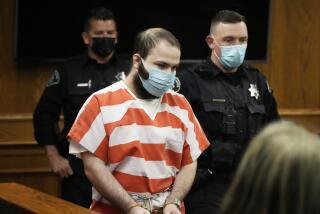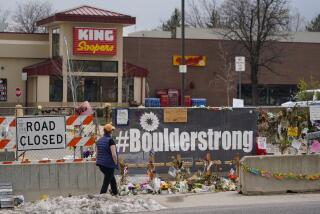Jurors in George Zimmerman murder trial have much to consider
- Share via
Murder trials often turn on forensic evidence such as DNA analysis, the use of a weapon and the degree of injury to a suspect or victim. Those issues have been heatedly debated in the George Zimmerman murder trial.
But for the sequestered jury of six women, much may depend on how a mother is steadfastly convinced that she can recognize her son’s screaming pleas for help.
On Friday, both sides relied on the testimony of two anguished mothers to end the second week of proceedings and leave the jury with powerful sounds and images to consider over the weekend.
“I heard my son screaming,” said Sybrina Fulton, mother of Trayvon Martin, the 17-year-old shot to death by Zimmerman. She was referring to the screams recorded on a 911 call made by a neighbor who heard the fight Feb. 26, 2012. Within seconds, there is a gunshot and the screams abruptly end.
Earlier, Fulton had described herself as the mother of two sons, one of whom “is in heaven.”
The defense then opened its case with Gladys Zimmerman, George Zimmerman’s mother. She was just as emphatic when, after listening to the recording and being asked who was screaming, she answered, “My son.” When pressed on how she could be so certain, she replied: “Because it’s my son.”
The question of who was screaming may become crucial as the jury sorts through the conflicting evidence in the trial of Zimmerman, charged with second-degree murder. Zimmerman says he shot Martin in self-defense. Determining who was the aggressor in the fateful confrontation could be a key issue for the jury.
After the prosecution rested Friday, defense attorney Mark O’Mara asked Judge Debra S. Nelson to acquit Zimmerman without sending the case to the jury. He argued that the prosecution had failed to prove its case, saying the evidence showed that Zimmerman acted in self-defense because he had reasonable grounds to believe he was in danger.
O’Mara also argued that there was no evidence that Zimmerman acted with “ill will, hatred and spite,” the grounds needed for a second-degree murder conviction.
“There are two people involved here. One of them is dead, and one of them is a liar,” prosecutor Richard Mantei replied. The prosecutor argued that Zimmerman had repeatedly changed his story.
Nelson refused to throw out the charge.
Throughout its case, the prosecution made the points promised in opening statements. Witnesses and documents were used to present Zimmerman as a police wannabe, an eager neighborhood watch volunteer who was growing more frustrated by crime in his community. When he saw Martin, a stranger walking on a rainy night, he called authorities to report someone suspicious. The dispatcher advised him to let the police handle it.
The defense insists that Zimmerman never followed Martin. Rather, the defense argues, Martin attacked Zimmerman, beating him with dozens of blows and battering his head on the ground. Photographs were admitted showing Zimmerman with a bleeding nose and two lacerations on the back of his head — injuries that prosecution witnesses said were minor and insignificant.
The prosecution has argued that the limited extent of the wounds makes Zimmerman’s version of events unbelievable. A barrage of blows should have done more damage to Zimmerman and resulted in more blood on Martin’s clothing, the prosecution said. None of Zimmerman’s DNA was found underneath Martin’s fingernails. None of Martin’s DNA was found on the gun, a prosecution expert said.
The defense, in its cross-examination, has already questioned those findings. The scene could have been contaminated by the rain that night, and the police did not wrap Martin’s hands in plastic. Martin’s wet clothes were stored in plastic, which could have led to degradation and poor test results as well, the defense said.
During cross-examination, the defense was able to use prosecution witnesses to make its points. Where the prosecution described Zimmerman as an avenger, the defense in its questioning portrayed him as a good citizen, making a personal sacrifice to help neighbors stay safe.
Where the prosecution said Zimmerman used his knowledge of police procedure and self-defense law to tailor his responses to authorities, the defense said he was trying to better himself by seeking a career in law enforcement.
The defense disputed that Zimmerman’s wounds were minor, but it also argued that their nature was less important than the fear Zimmerman felt: He has contended he had reason to be afraid — the key criterion for self-defense — and reacted accordingly. Such action is within the self-defense law, defense attorneys indicated in questioning a lawyer who taught Zimmerman about the law in a class.
There are no direct eyewitnesses to the moments before the two faced off. At least one witness, John Good, one of Zimmerman’s former neighbors, said he saw the pair tussle. Martin, in a dark sweat shirt, appeared to be on top of Zimmerman, Good testified. He said he heard cries for help coming from the person on the bottom.
The jury will have to wade through the conflicting forensic evidence. But it will also have to try to reconcile the different versions of events that Zimmerman gave authorities.
He was interviewed by police hours after the shooting, and later again by police. On the afternoon of Feb. 27, the day after the shooting, he walked authorities through the scene, and his statement was recorded on video. All versions were played for the jury, along with recorded calls to dispatchers and selected parts of Zimmerman’s interview with Fox News’ Sean Hannity.
Zimmerman gives substantially the same story in each statement, though the details vary. The defense dismissed the differences, getting witnesses to agree that they were the types of different accounts one could expect from a person who had gone through a traumatic experience. The prosecution argued that Zimmerman was embellishing at key points to put himself in a better light to sustain his self-defense argument.
But as the jurors contemplate the case during their second sequestered weekend, the testimonies of two anguished mothers, who each insisted it was her son who was screaming for help, were among the last voices heard in court.
More to Read
Sign up for Essential California
The most important California stories and recommendations in your inbox every morning.
You may occasionally receive promotional content from the Los Angeles Times.











